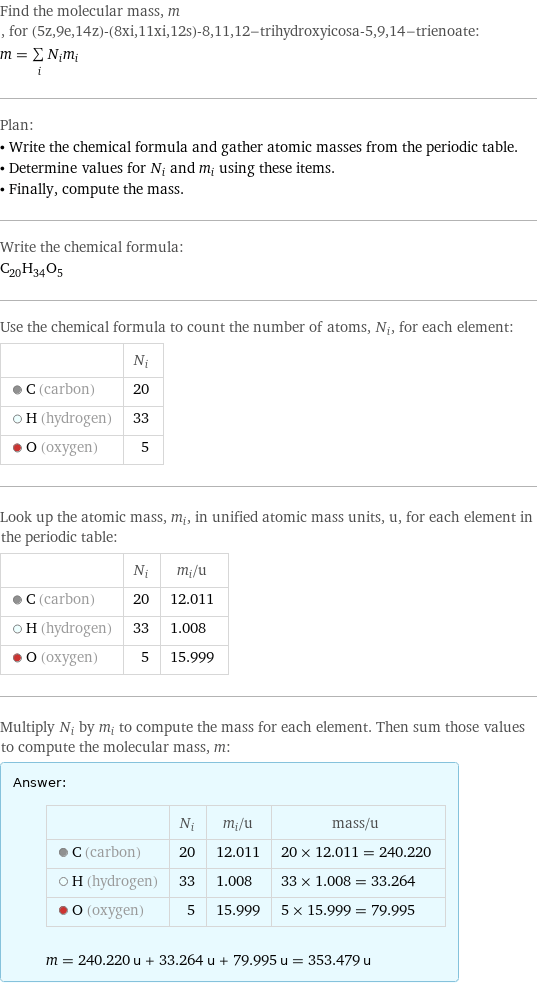Input interpretation

(5z, 9e, 14z)-(8xi, 11xi, 12s)-8, 11, 12-trihydroxyicosa-5, 9, 14-trienoate | molecular mass
Result

Find the molecular mass, m, for (5z, 9e, 14z)-(8xi, 11xi, 12s)-8, 11, 12-trihydroxyicosa-5, 9, 14-trienoate: m = sum _iN_im_i Plan: • Write the chemical formula and gather atomic masses from the periodic table. • Determine values for N_i and m_i using these items. • Finally, compute the mass. Write the chemical formula: C_20H_34O_5 Use the chemical formula to count the number of atoms, N_i, for each element: | N_i C (carbon) | 20 H (hydrogen) | 33 O (oxygen) | 5 Look up the atomic mass, m_i, in unified atomic mass units, u, for each element in the periodic table: | N_i | m_i/u C (carbon) | 20 | 12.011 H (hydrogen) | 33 | 1.008 O (oxygen) | 5 | 15.999 Multiply N_i by m_i to compute the mass for each element. Then sum those values to compute the molecular mass, m: Answer: | | | N_i | m_i/u | mass/u C (carbon) | 20 | 12.011 | 20 × 12.011 = 240.220 H (hydrogen) | 33 | 1.008 | 33 × 1.008 = 33.264 O (oxygen) | 5 | 15.999 | 5 × 15.999 = 79.995 m = 240.220 u + 33.264 u + 79.995 u = 353.479 u
Unit conversions

353.48 Da (daltons)

0.35348 kDa (kilodaltons)

5.87×10^-22 grams

5.87×10^-25 kg (kilograms)

353.49 chemical atomic mass units (unit officially deprecated)

353.59 physical atomic mass units (unit officially deprecated)
Comparisons as mass of molecule

≈ 0.49 × molecular mass of fullerene ( ≈ 721 u )

≈ 1.8 × molecular mass of caffeine ( ≈ 194 u )

≈ 6 × molecular mass of sodium chloride ( ≈ 58 u )
Corresponding quantities

Relative atomic mass A_r from A_r = m_aN_A/M_u: | 353

Molar mass M from M = m_aN_A: | 353 g/mol (grams per mole)

Relative molecular mass M_r from M_r = m_mN_A/M_u: | 353

Molar mass M from M = m_mN_A: | 353 g/mol (grams per mole)